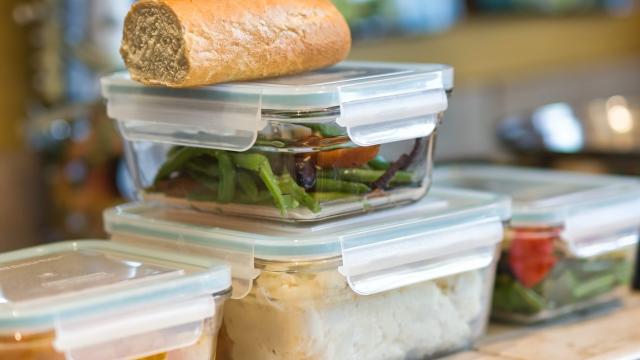If you’re like me, remembering to eat your leftovers is a losing game. Every week, I diligently scoop uneaten tilapia, sweet potatoes, pasta, meatballs — hell, even a half-eaten avocado — into airtight food storage containers. And every week, I toss those suckers in the disposal then descend into a low-grade shame spiral about my own wastefulness.
And unfortunately, guilt alone isn’t sufficient to deter me from doing it again, because it happens repeatedly. If I get one or two (out of ten) leftover quesadilla triangles into a child’s mouth, I consider it a “success.” If I can get my husband to polish off some five-day-old meatloaf so I don’t have to toss it? Champion status.
In other words, the bar is low. And I would like to do better. (Also, I would like to cook less. Cooking for picky kids — who call your attempts at breaking up the mundane dinner rotation with new, radical flavours like lemon and onion “disgusting” — blows.) If you too often send carefully packed leftovers into your fridge to die, try employing some of these methods so they avoid a similar fate in the future. As with most changes, it’s all about creating new habits.
Label and date your leftovers
If you’re having trouble remembering those dastardly dumplings, add a visual cue to make them stand out in the refrigerator. Either write specific container contents or simply “Leftovers” on each label, along with the date. (The labels can be nothing fancier than masking tape.)
It may seem obvious, but to family members who don’t do the cooking, or who missed the meal the first time around, having that information readily available about what the mysterious mush of peppers and rice actually is, and how long it can reasonably be eaten, can help save it from a trip down the drain.
Put them in one designated area of your fridge
If you don’t have one designated area of your fridge that is exclusively for leftovers, you should. If you tend to stash them wherever you can find space (guilty), chances are high they’ll get lost in the abyss.
Pick a shelf (or side of a shelf), a drawer, or a door compartment that is Leftover Central, so you always know where to find them. Make sure they’re front and centre, not tucked in back, with the oldest items in front. (How long food lasts varies, but as a general rule, most food is safe to eat within 3-5 days of storage and should be tossed after seven days.)
Schedule a consistent night to eat leftovers
We’ve got Taco Tuesday, how about Leftover…Lednesday? OK, it’s not going to form a catchy alliteration, but pick a night, any night, and designate it a Leftover Night. Keep it the same night every week. Build it into your meal plan. Like the cognitive ease of wearing a uniform, it takes the stress out of answering the dreaded “what’s for dinner?” question at least once every week.
Post leftovers on the outside of the fridge
For my “out of sight, out of mind” brethren who don’t notice leftovers unless they basically stand up and sauté themselves, write them all down and post them to the outside of the refrigerator. This goes for side dishes, as well as mains. Keep a small dry erase board magnetized to the refrigerator door so you can easily revise the list every week.
Repurpose leftovers into a new meal
Let’s face it, much of the reason we don’t eat leftovers is because they’re boring and we didn’t like them much the first time around. To combat the monotony of facing the same breaded chicken again, don’t just reheat, reimagine it.
Put leftover protein, rice and vegetables into salads, stir-frys, soups, or pasta. Concoct new uses for individual ingredients. Broccoli can be added to omelettes, beans can be tossed into a quesadilla, salmon can be turned into fish tacos or pan-fried fish cakes. At the end of the week, turn leftover veggies into vegetable stock.
A few other tips: Store uneaten food promptly; don’t leave it out at room temperature for longer than two hours. Keep your refrigerator temperature below 40 degrees, ideally between 36 and 38 degrees. And reheat anything in the stove, oven, or microwave — not a slow cooker, as the slow heating allows harmful bacteria to grow.
And maybe just don’t cook as much
The easiest way to avoid food waste? As this article advocates: don’t cook as much. Seriously. If the ground beef you’re using for taco night consistently creates too much, split it down the middle and use half for tacos, half for meatballs the next night. (Just make the meatballs smaller so it’ll still look like a decent-sized meal.) Now, this is a leftover tip I can get behind.

Leave a Reply
You must be logged in to post a comment.